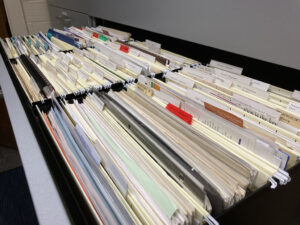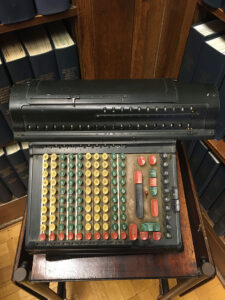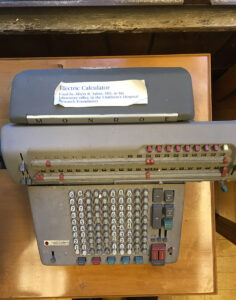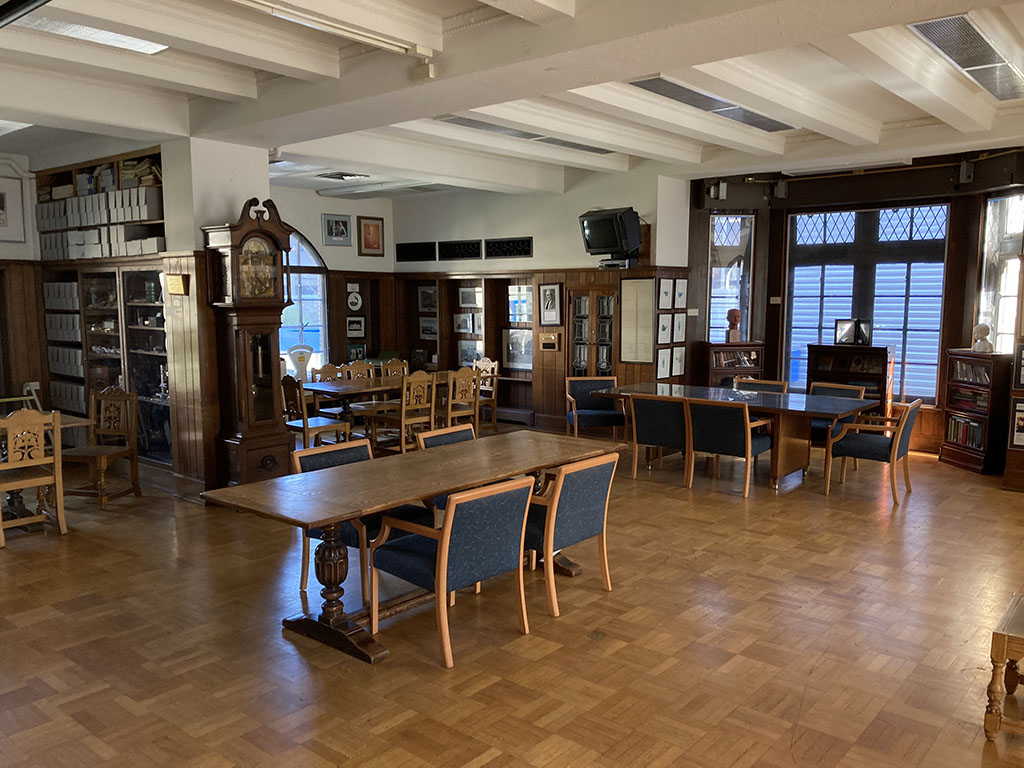
View of Mitchell-Nelson Library, formerly the Pratt and Research Foundation Library, location of the Cincinnati Children’s Hospital Medical Center Archives. Cincinnati Children’s.
Archival Spotlights: Post #3
The Society of Ohio Archivists Advocacy and Outreach Committee wanted to celebrate Archives Month in a new way, so we featured three archives in a series of posts we are calling Archival Spotlights. Since the Archives Month poster’s theme was “Ohio’s Healthcare Workers: The True Heart of it All,” we felt it a good idea to feature archives that focus on healthcare or have interesting collections related to healthcare.
About the Cincinnati Children’s Archives and its Collections
By A&O Committee member Erin Wilson, Ohio University Libraries
The Cincinnati Children’s Archives are a unique community resource, preserving the history of local patient care, institutional research, and developments in pediatric medicine. With collections dating back to the hospital’s founding in 1883, the Cincinnati Children’s Hospital Medical Center (CCHMC) Archives document nearly 140 years of healthcare in the Queen City.
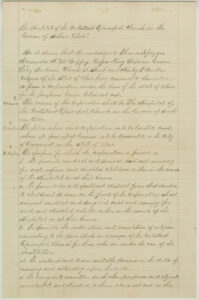
Articles of incorporation of the Hospital of the Protestant Episcopal Church in the Diocese of Southern Ohio, 1883. Cincinnati Children’s.
The Center’s first facility, the “Hospital of the Protestant Episcopal Church” was a rented home in Cincinnati’s Walnut Hills neighborhood with a capacity of fourteen beds. The hospital was cooperatively governed by a Board of Trustees and a Board of Lady Managers until 1921. The first annual report from 1884 concludes with a historically significant statement by the Board of Lady Managers affirming their commitment to patient admission and care regardless of faith, race, or ethnicity, “all being welcomed and treated alike…”
The CCHMC Archives were established in 2014 when the first part time archivist was hired to assess the collections. In 2021, the first full time archivist was hired to manage and develop the program further. Bill Gerhardt, MD, a community pediatrician and member of Cincinnati Children’s Medical Staff, volunteered to be the medical center’s first staff historian in 1980—a role he dedicated himself to for 35 years.
The Archives are built largely on the work and material Dr. Gerhardt collected and saved from 1980-2015 and have since grown to include an impressive variety of materials ranging from oral histories to three-dimensional objects, artwork, scrapbooks, and more. Housed at the Medical Center’s Mitchell-Nelson Library, the CCHMC Archives facilitate departmental histories and offer research appointments to staff, medical students, and the general public.
Interview with Jim DaMico
Jim DaMico is the Cincinnati Children’s Hospital Archivist. He was kind enough to answer some questions about the CCHMC Archives for the Advocacy and Outreach Committee (A&O).
A&O: What is your favorite collection in the Cincinnati Children’s Archives?
Jim: That is a great question! The collections go back to the founding of the hospital in 1883 when a group of civic-minded women representing parishes of the Episcopal Church in southwest Ohio met in June to discuss establishing a Diocesan Hospital for Children. By November 1883, Bishop Thomas A. Jaggar and attorney Alexander McGuffey drew up incorporation papers.
My favorite collection is a toss-up between Material Culture (objects) and the early patient history books (MSS). My favorite objects are a pair of electric calculators, the Monroe “Monroematic” Model 88N-213 and a Marchant, circa 1930s–1950s, the supercomputers of their time. The Monroematic, made in the 1950s was used in Dr. Sabin’s research laboratory. The Marchant’s use is not known but was most likely also used in a research lab.
We also have a pair of portable infant incubators. One is from Jewish Hospital and the other from Cincinnati General Hospital. These were used by hospital staff to transport a sick child via car or cab to Cincinnati Children’s Hospital Medical Center for treatment.
Both of the above examples show the arc of innovation in healthcare from transport to computation. For example, the incubators were used as late as 1968. Nowadays, patients are transported via state-of-the-art mobile intensive care unit ambulances that are staffed by critical care nurses, respiratory therapists and EMT’s in a child friendly environment that allows for the transport of critically ill newborn and pediatric patients.
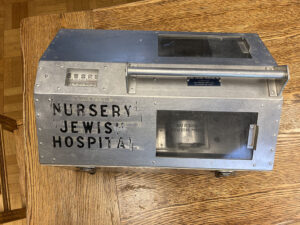
The portable infant incubator was invented by John L. Prager and patented in 1949. In 1968 when Mrs. Katz, RN, started working in the Jewish Hospital Nursery, this lightweight, hand-carried isolette was used to transport high risk infants to Children’s Hospital. Children’s Hospital.
A&O: How does your current job compare to other archives positions you have held in the past?
Jim: This is my first non-historical society/museum job. I never thought I would work in healthcare yet here I am. I work in the original Research Foundation building where innovators like Albert B. Sabin, MD, Josef Warkany, and Beatrice C. Lampkin, MD, worked on research such as the oral polio vaccine, and experimental teratology, the study of congenital malformations. This innovation continues today.
This is the first archives job that I feel valued in which is huge. I have a supervisor that I have regular one-on-ones with and is always available to answer my questions. I look forward to coming into work!
I am truly a solo archivist now and the first full-time hospital archivist. The type of collections that I am working with has a much narrower scope than what I have worked with in the past but I also have more opportunities to learn new things. For example, in my first two months here I undertook an oral history project to document the impact of a highly respected doctor and researcher that had unexpectedly passed away. This individual taught and mentored hundreds of fellows, did groundbreaking research into sepsis and led the hospital’s COVID-19 response. Thankfully, I have a great team of colleagues including a history committee that helped navigate me through this project using Zoom, creating a SignUp Genius calendar, and connecting me with potential individuals to interview.
A&O: What do you like most about your job?
Jim: Building off the great work that my predecessors (two part-time archivists) accomplished, I am increasing the visibility of the archives and creating a welcoming environment for people to come and do research. I really love meeting the medical students, nurses, doctors, laboratory technicians, researchers, and public safety officers who come into the library and archives space which is located in the original Research Foundation building, the oldest structure on the Burnet campus. I learn about the work they do and I tell them about the collections and history of the hospital and always invite them to come back. My biggest role is to be an ambassador and connect the history of the hospital with the staff that help care for the children and young adults that come through our doors.
Learn more about the Cincinnati Children’s Hospital Medical Center Archives at https://prattlibrary.cchmc.org/cincinnati_childrens_archives.
Twitter: @CCHMCArchives
Facebook: @CCHMCArchives
Instagram: CincinnatiChildrensArchives
Last Updated on October 31, 2022 by janet_carleton

